
|   |

|   |
Ashta Nayakan - a Rasika's viewpoint - Pushkala Gopal e-mail: pushkala.gopal@gmail.com Photos: K Shanthakumar March 15, 2022 This was, is, and will be a historic event. The theme of Ashta Nayakan, premiered at Kalakshetra's Rukmini Arangam on the 5th of March was inspired by a lacuna in literary works, and had original lyrical compositions with a never-before line-up of seasoned Nartakas - male Natya artistes, in solo portrayals of each Nayaka. Nirmala Nagarajan was the conceptor, the author of the literary pieces and the producer of the event. 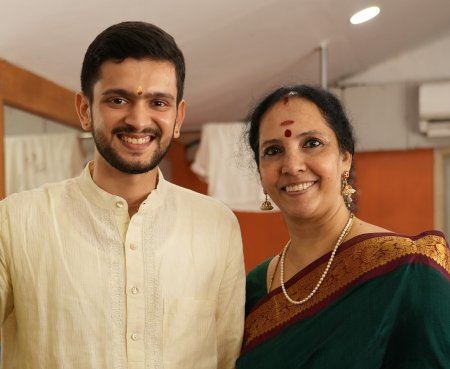 Abhilash Venkitachalam & Nirmala Nagarajan The individual choreographic inputs were those of the dancers themselves. Specially created music and the presentation of explanatory and transliterated text through visuals on screen took the Rasika through a literary, aural and visual spectacle. The technique of introduction to each piece visualized as comments by two other narrator-performers or Sutradharas, who brought a dramatic quality to their bi-lingual dialogues and abhinaya nuances, aided the unfolding of the chronicle in an audience friendly manner. The stage setting was simple, yet slick in the shifts between the characters and the presenters. The solos as well as the narrators' interludes were enhanced with excellent lighting cued and delivered with expertise. Music was specially composed by Abhilash Venkitachalam. The visualization, production, composition, performance were all on a level of excellence and was developed to an impeccable mix of group and individual inputs. The two vocalists, Deepu Nair and Abhilash himself, gave the lyrics the prominence they deserved and the melodic development through the improvised sections was particularly symbiotic. That they chose to render the set sections together and have free range in the individual bits made the music enhance the natya and the sahitya modes. The overall variety in the musical structuring of the pieces showed sensitive direction (Abhilash) and alert handling of the orchestral and vocal sections with finesse. Flautist Shashidhar and vainika Anantanarayanan were at their melodic best. Last, but holding it all together with high energy, a thesaurus of rhythmic cues, and varieties of patterns was mridangist Jagadeesh Janardhanan supported by Jyothsna Menon on nattuvangam. The only question I had on the music personally was the paucity of more Pracheena, even Bhashanga ragas. I do not know if the composer intentionally avoided ragas like Kamas, Huseni, Anandabhairavi etc normally associated with sringara poetry in the Carnatic system. Barring the introductory Reethigoulai music and one brief Surutti in the last Ragamalika, many of the ragas were from those that have become popular in the last six- seven decades - Valaji, Abheri, Kalyanavasantham, Charukesi, Rasikapriya. I do grant that Vasantha and Mohanam are Pracheena ragas. While the melodies were effective in themselves, one could not help missing the weight of heavier ragas in a couple of the pieces where the abhinaya content was not light. 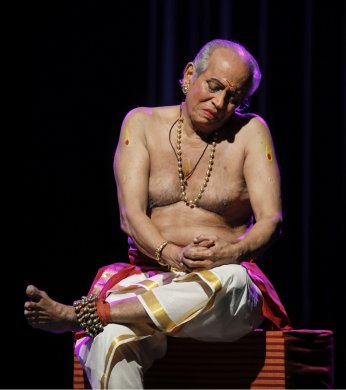 A Janardhanan 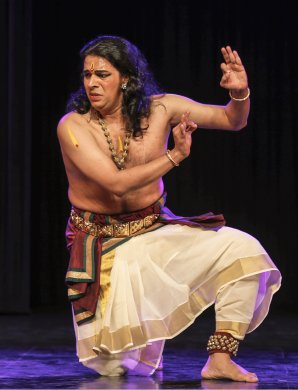 Sheejith Krishna 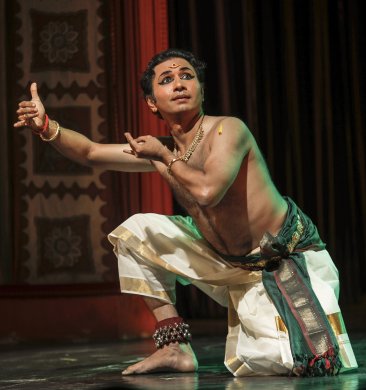 Shijith Nambiar 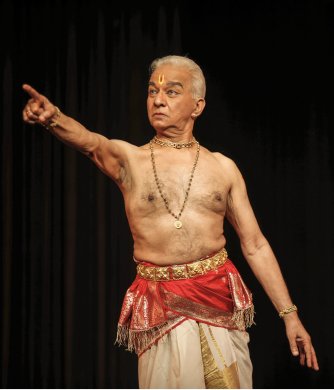 VP Dhananjayan All the star performers of the evening are Kalakshetra alumni. It was both fascinating and endearing to see how the individual construct of each piece brought out the USP of the artiste. For instance, veteran Janardhanan whose main emotion was viraha or separation in love, expressed much through internalization and angikabhinaya. Seated as he was, one could still get the import of deep suffering quite easily. His metaphors were classic and varied from Sheejith Krishna who used more contemporary imagery in his visualization of a remorseful and penitent Nayaka. Here again, the use of total body and the inner dilemma as was evident from the torso movement was uniquely impressive. Shijith Nambiar's piece was exploited musically. As a Nayaka restless for the union, the delivery of the piece more as a Kriti and less as a Padam worked to his advantage enabling the restlessness to be harnessed through beautiful movement interspersed with sequences of narrative. Dhananjayan's forte, his mukhajabhinaya, was exhilarating, in the portrayal of a Nayaka who is now 'fed up with her lies'. He also depicted his Nayaki in inimitable, engrossing detail. G Narendra's seeking out of his Nayika to express his love was in a 'no holds barred' mode. His unrestrained expression of need and yearning was evident, but the odd reaction was whether some moments of his performance were tongue in cheek, with hasya superseding the sringara? 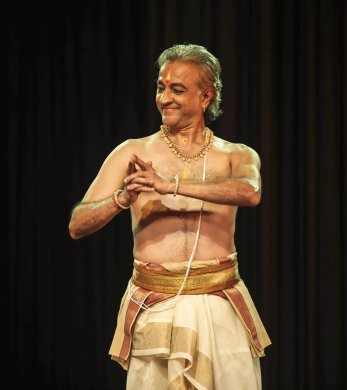 G Narendra 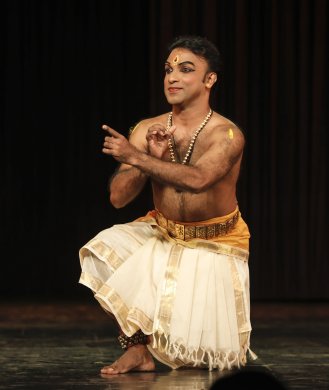 Haripadman 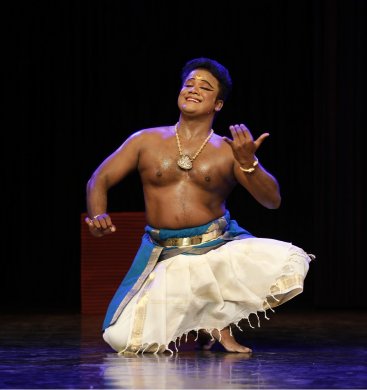 Kali Veerapathiran 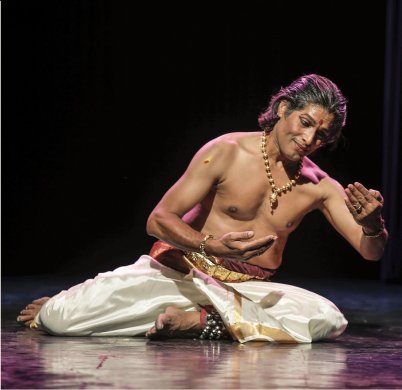 P T Narendran Haripadman sensitively portrayed a rare Nayaka in waiting: commitment, innocence and sincerity being visage of the Nayaka. Kali Veerapathiran brightly expressed the equivalent of a Swadhinapatika, but the reference to valour in the composition outweighed the aspect of conjugal paarasparyam. The disappointed lover was P T Narendran's theme and though this piece was explained as a combination with associated anger, love reigned here. A variety of subtexts of natya were introduced in the imaginative exploration by the dancer. The Sutradhar Rajkamal and his cohort Gopika Pillai were lively and declaimed and acted their parts with savour and resonance with the theme. Would I suggest a modification here? The content delivered by the narration, for a start. While the nature or the starting point of the Nayaka was fixed- the senior artistes went into a freewheeling mode and there were times when the verbal narrative content was at variance with what was delivered in the abhinaya flow. Without taking away from the performance of the young actor Rajkamal, who is clearly gifted, the unsubtle nature of for example, 'should I , should I not' repeated enough times to be a humorous delivery was not replicated in the Nartaka's abhinaya, which showed a deeper dilemma very effectively. Natya, with such consummate performers speaks for itself. While the narration in a dramatic style opens up the literary content, it should not superimpose or speak for the dancer, except on a SUGGESTIVE level. It was a memorable event, redolent of a world premiere, with incipient excitement and festivity. The audience was truly transported on many different levels of Rasikatvam. This premiere event had artistes introduced three times: first by the announcer, then by the composer and finally for the thanksgiving curtain call. It was a hugely emotional moment for Dr. Nirmala, the prime facilitator here. One understands the momentous nature of this. Another time it might be advisable to split all the valuable comments she shared into three bits: an introduction to the why and what of the literature delivered at the beginning, a how of the artistes and artistic process delivered somewhere in the middle, and a vote of thanks delivered at the end along with the presentations. It would professionalize the production even more to use the visual screen to project artistes' names early. The anchor, Aparna Ramkrishnan was fluent and spot on. I take away many points of learning from this experience. When the involvement in the role playing is given, one is not prompted to compare one dancer with another - so senior / junior, slim / heavy, young /old - none of these factors affected my enjoyment of the pieces. When male dancers play Nayikas even transiently, their effectiveness is immediate - it is less easy to be convinced about a Nartaki playing the male. There is an observation that this theme is not an exact counterpart of the age-old Ashtanayika in the Natya parampara, but all the Ashtapadi works inspired by the Gita Govindam which followed were not complete clones either! I find that Ashta Nayakan has covered new ground and has a varied approach to each Nayaka visualized here. And some fresh abhinaya pieces for Nartakas to own. Some creators previously have written their pieces apart from composing and choreographing them, Nirmala Nagaraj deserves both congratulations and gratitude for the creation of this work as an Achaarya- Sahityakarta. I was told that the group had two rehearsals. For a multi-genre production like this, one must compliment the alertness of every complement of this production for being there at the right moment, doing things right. The seamlessness of one section segueing into the next was a treat. There are moments in life when one is privileged to 'be there' and this surely was significant in that sense. I say it again: This was, is, and will be a historic event. 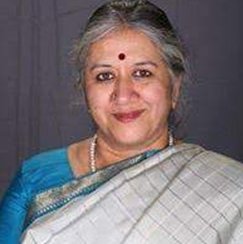 Pushkala Gopal, MBE has served in the performing arts sector mostly in the UK, with some stints overseas, and quite actively here in India in the last couple of years. Her work as a performer, composer, mentor, director straddles the theatrical and the educational genres / fields. |